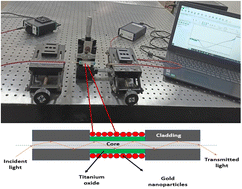Selective detection of diethanolamine utilizing an LMR/LSPR-based optical fiber sensor
Abstract
Diethanolamine (DEA) is used for amine wash to remove toxic gases such as hydrogen sulphide (H2S) while processing crude oil and in other pharmaceutical products. The detection of diethanolamine is of prime importance to avoid its harmful impact. In this study, we have designed a lossy mode resonance (LMR)-based optical fiber sensor for the detection of DEA. An optical fiber probe was fabricated by coating a bulk layer of titanium dioxide (TiO2) on the core of the optical fiber (probe-1). To extend this study, we prepared biosynthesised gold nanoparticles and coated them on to the top of the TiO2-layer-coated probe (probe-2). The surface structure was confirmed using characterization techniques such as FESEM, HRTEM and UV-visible spectroscopy. Further, a comparative study among probe-1 and probe-2 has been carried out in terms of their performance parameters such as sensitivity, figure of merit, limit of detection, repeatability and response time. The sensitivity of the TiO2 bulk layer/AuNP bilayer-coated optical fiber probe (probe-2) was observed to be 16 079.63 nm RIU−1 (0.074 nm mM−1), which was approximately double the sensitivity of the TiO2 bulk layer-coated optical fiber probe (probe-1). Selectivity experiments were also performed to confirm the high sensitivity of the sensor towards DEA.



 Please wait while we load your content...
Please wait while we load your content...